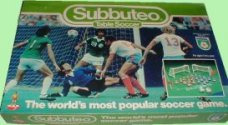
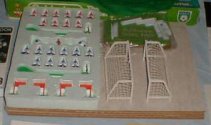
| Peter Upton's |
Subbuteo Tribute Page. |
|
The North American Experience. |
|
Jokari and the NASL Golden Age. |
Every established human activity seems to gain a golden age. An era that participants can look back on, saying "things were much better then", and crucially, "things will never be that good again." For instance, the golden age of motoring was back when the roads were nearly empty, and you could park anywhere you liked. The Golden Age of Science Fiction has been officially set to the early 1940s, but while this was still being decided some wag argued that the Golden Age of Science Fiction was in fact "twelve". That being the year in your life when the magic of science fiction adventure would take hold.
I use this as a preamble, because the same criteria applies very nicely to Subbuteo. Now I happened to be twelve years old in 1981-82 which, as luck would have it, was a high water mark in Subbuteo production. The new lightweight was replacing the zombie, there was an ever increasing number of teams, the team boxes started to display the whole team to show off the smart new machine painted kits, there were stadiums, there was hockey, there was... err Sport Billy.
Subbuteo was also expanding its export markets at this time, and it was tempted by the largest market of them all - North America. Mainly I think, because this Subbuteo expansion coincided with an increased awareness in Britain of the North American Soccer League. With interest in soccer increasing in the States, and Canada, what a good opportunity to sell them the world's best table football game. Distribution was handled by a firm called Jokari/US, inc. If 1982 is my own personal Subbuteo golden age, then it is also America's.
These pages are going to have a look at the whole US (and Canadian) range circa 1982-87, but first, I thought it would be helpful to European visitors if I gave them a brief history of the NASL - North America's most successful attempt at bringing soccer to the masses (at least until recently).
A Brief History of the NASL.
The 1966 World Cup final wasn't just great news for the English football fan. The final was broadcast live in the States by NBC, and the favourable response caused American Sports promoters to start a pro soccer league. Two rival leagues were started, but after a year these merged to form a 17 team North American Soccer League. This didn't prove very successful at first, and after all but five teams folded in 1969, the league went semi-pro. In the early 1970s, this league quietly grew, while promoters concentrated on making the game popular as a participation sport for children.
However, the NASL suddenly became big news in 1975 when Pele signed for New York Cosmos on a $4.5 million, three year contract. He was followed by other ageing superstars such as Bobby Moore, Franz Beckenbauer and Johan Cruff (not to mention Brighton and Hove Albion legend Peter Ward - voted NASL most valuable player in 1982). The crowds grew, and by 1978 the league had expanded to 24 teams.
From the outside, (and probably from the Subbuteo Games Ltd boardroom), things were going well at the NASL. But in truth, costs were spiralling, and the 1978 expansion was actually the beginning of the end. Teams began to fold at an alarming rate in the early 1980s, and the league had reduced to just nine teams for the 1984 season. The Championship Final of that year (Chicago 2 : Toronto 0) was the final NASL game ever played, and the league officially folded in March 1985.
If that makes the NASL history seem simple, it isn't. The league structures, points systems, and separate indoor seasons, make things a little more complicated. But add this to the alarming turn-over of clubs, coupled with the fact that various clubs switch towns (and therefore names) during the close season (i.e. Memphis Rogues become Calgary Boomers), and you have a history that needs a whole website (or two) to cover in detail. If you're interested, try visiting Dave Litterer's NASL site, or the Chris Page site.
The Jokari NASL Box Set.


As shown on the international box sets page, there was a slightly revamped club edition produced for the North American market. In this edition, the polystyrene interior was reduced in size, and fills less than half the box. This protected the two teams (usually in standard red and blue), four flags (on the small half-way line bases), and the balls. The rest of the box held two standard goals, the pitch, plus a fold out "paper fiber" game board, cardboard "goal pads" and some plastic clips. It seems these last items were added by Jokari to improve the set, and help its appeal as a board game. Jokari provided a sheet of instructions, simply typed onto orange paper, with these extras accessories. I've quoted parts of it here, because it explains their use better than I can (as I've not tested a board).
"Instructions for using the Fold-Out Game Board - Unfold the game board and lay it flat. We recommend that you put tape down the middle of the game board... The 10 white clips are used to secure the green cloth to the fold-out game board. Two clips are used on each end in which the goals are located, and 3 clips are evenly spaced along each side. When attaching the clips, please make certain to gently stretch the wrinkles out of the green playing surface to enable smooth play." (because they'd stopped making the nice baize pitches by this time!!)
"After the green playing surface is attached, place the Subbuteo goal pads at both ends of the playing surface. Position the goal pads so that the goals rest on them during play. The goal pads may also be used for sideline throw-ins to provide more room for your Subbuteo player if needed." (extra goal pads were provided - my set seems to have five.)
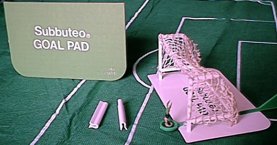
"Care of the Subbuteo Game Board - Your Subbuteo fold-out game board was sealed at the factory to ensure high quality. Because the fold-out board is paper fiber, it is sensitive to moisture and you may experience a slight bowing in some of the panels as the humidity changes. To minimize bowing of the board, store it in a flat position (rather than on edge), like under a bed. For best results, fold up the board, and tie it with string to keep it compressed. If the board does warp or bow, you can usually eliminate most of the bow by using a damp sponge, or water mist to wet one side (inside the bow).
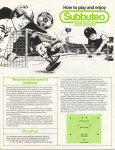
Jokari also printed their own intruction booklet, explaining the basics of the game. You could send for the English advanced rule book, but the Jokari one is nice and simple, and more than adequate for normal play. There was also an order form/price list included to allow the purchase of further teams and accessories.
Just to confuse matters further, these were two alternative boxes for the American market. Both seem to be from the same era, and despite having different names, they both seem to have the same basic contents. Perhaps the "international" version still had the card game board?
The International Edition (circa 1985-6).
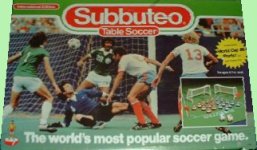
This set is a simple update of the NASL edition. The version shown featured a "World Cup 1986 poster", and so is probably dated just after the demise of the NASL. The NASL logo on the lid was replaced by an advert for the enclosed World Cup poster. You can see that this was now the red logo era. The smaller red logo in the top left corner of the box called this an International edition.
The Jokari Club Edition (circa 1985).
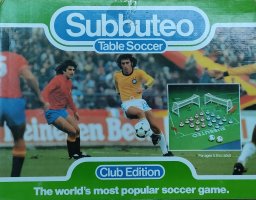
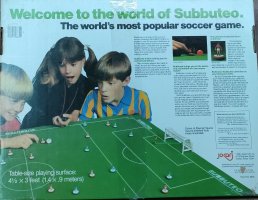
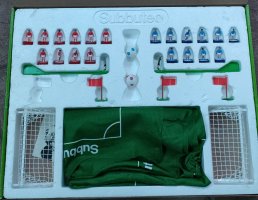
I think this set was the final Jokari edition, and sees the familiar picture and name arrive in the USA range, with a blue logo this time.
Again, this set had the 1986 World Cup poster advertised on the front, and dates (originally) from 1985. That gives the set a similar date to the International edition, and it has the same contents, so that is a little odd. The club edition had a full polystyrene insert (although again it only catered for four flags).Check out the boy on the reverse in the yellow and blue stripes (a Rochester Lancers fan?)
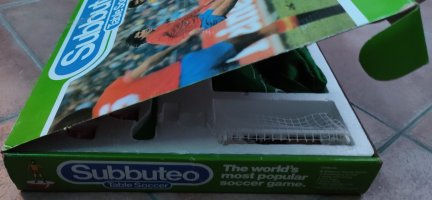

One change with the Jokari boxes was that the lid became part of the box, and featured a neat lift-up/tuck-in design. Note also the lovely Subbuteo player illustration on the box. These should have been used more widely.
A big thank you to Cristian Giovangiacomo for sending in the detailed pictures of this set.
Teams available in America.
1. NASL sides.
Subbuteo first produced NASL teams in the big team expansion of 1978, which saw team colours increase from 190 to 322. There were twelve teams produced in this first range - with the names and details taken from the twenty team NASL of 1976 (San Diego arrive that year, while Boston and Philadelphia folded at the season's end). There's actually one name error here, as Minnesota's nickname was Kicks, and not Minutemen. I'm not sure whether these teams were actually produced for the American market, or whether they were sold to British/European punters who had just become aware of the NASL.
However, this whole range was replaced in 1982 by a new one - this time definitely aimed at the US market. The original planned size of this range was twenty-one teams, and this included all the teams that competed in the 1981 season of the NASL. This was already three teams less than the league had the previous year. One of the teams to fold was Washington Diplomats, but Detroit Express chose to move to Washington and become the Diplomats, so they remained in the range, which was as follows (in Subbuteo numerical order 540-560):
T
Vancouver Whitecaps (540), Chicago
Sting (542), New York Cosmos (543), Tampa Bay Rowdies (545), Montreal
Manic (549), Fort
Lauderdale Strikers (550),
By the 1987 price list, there were only three NASL teams left available - 542 Chicago Sting, 543 New York Cosmos, and 545 Tampa Bay Rowdies. All three franchises had attempted to carry on beyond the end of the NASL, by joining the Major Indoor Soccer League (details of which are below).
1, 2, 5, 6, 9, 10, 13, 18, 19, 21, 25, 39, 41, 42, 47, 48, 50, 53, 55, 56, 57, 58, 59, 67, 68, 82, 85, 100, 107, 114, 133, 138, 149, 152, 156, 157, 159, 160, 161, 162, 163, 164, 165, 166, 174, 189, 191, 194, 207, 211, 214, 219, 221, 225, 231, 232, 246, 271 (USA national team), 281, 300, 318, 320, 329, 330, 331, 346, 352, 355, and 502.
While this list is targeted at a US audience of course, I think it may also give an indication as to which teams were proving popular in England, and maybe even Europe as a whole.
There is a big reduction in teams by the time of the 1987 price list, but the teams that qualified for the 1986 Mexico World Cup are added to the list (to cover interest in that tournament in the States). So the teams in 1987 are as follows:
013, 019, 021, 025, 039, 041, 048, 050, 057, 058, 067, 100, 152, 156, 157, 161, 163, 164, 165, 166, 194, 214, 225, 246, 271, 318, 329, 331, 352, 355, 402, 481, 531, 634, 635, and 637.
Note that Jokari seem to be using up their old stock for the World Cup range, so although they have Paraguay, Hungary, and Iraq at 634-637, we find that Mexico are still 157, and England still 329 etc.
It's also important to note that both price lists state that "sometimes a team may change uniforms. In this case we try to ship the most current team colors regardless of the color in the chart". So don't rule out other sides being exported to the States - although you still had to order them under the old numbers.
3. The Nearly-Men - The Major Indoor Soccer League 1981-82. (Unreleased teams).
| Eastern Division | Ref No | Western Division | Ref No | |
| Baltimore Blast | 592 | Denver Avalanche | 591 | |
| Buffalo Stallions | 584 | Kansas City Comets | 586 | |
| Cleveland Force | 589 | Memphis Americans | 588 | |
| New Jersey Rockets | 582 | Phoenix Inferno | 587 | |
| New York Arrows | 581 | St Louis Steamers | 580 | |
| Philadelphia Fever | 583 | Wichita Wings | 585 | |
| Pittsburgh Spirit | 590 |
Jokari, advertised this league as "coming soon" in 1984. It never arrived. At that point, the team reference numbers had been allocated (580-592), but the teams were already out of date, and the American soccer boom of the 1970s was spluttering to a sad end. 1984 was the last year of the North American Soccer League, and the MISL found suddenly found itself the top professional league in the US.
We know which year Jokari had looked at for team details, because American soccer leagues seem to have an ever changing line-up of franchises, and 1981-82 was the only year that New Jersey Rockets took part. So what would these teams have looked like? Pleasingly, there is a great archive of MISL teams and pictures at one of my favourite websites - NASL Jerseys. There are a few too many teams using the American Flag as inspiration (blue kits with red and white trim abound), but also quite a few quirky things from the era of Admiral kit excesses.
This team selection would have been a great match for the Subbuteo Indoor Edition (and the Indoor arena was sold as a separate accessory in the US - see below). However, that might have been part of the problem. The Indoor league was not a full eleven-a-side competition. So would these teams have needed to be sold in a different size box? Or would they just be sold as a MISL "squad"?
The North American Accessory Range.
There's nothing much in the North American accessory range that wasn't available in Britain and Europe in some shape or form. But there were a few different reference numbers used - and I've illustrated them here. My NASL set had a price list "valid until June 30, 1982", plus a poster which is ©1984. The poster is a second edition of this item. and has new accessories, and a reduction in NASL teams. I've also been sent a copy of a further US price list "valid until June 30, 1987". This list reduces the number of teams available, but still has a good range of accessories. It also sees the arrival of a couple of later sets C205, and C208. Note that Jokari are still using "C" numbers although these had been replaced in the UK by 1984.
C50: Substitutes/Reserves.
Three standard reserve playing figures in blue.
C51: Substitutes/Reserves.
Three standard reserve playing figures in red.
C193: Three Ariva Balls.
A set of three Ariva Classic (tm) white moulded
balls.

In Europe this set was sold as C190. As this is the only set where this happens, it must be an error - but this set is quoted as C193 in all the American literature from 1982 to 1987. The Ariva is the ball illustrated on the Jokari instruction booklet, and also appears in some NASL sets.
C1900: Indoor Arena.
comes with a smooth and durable felt surface,
walls with plastic fitments, one indoor ball, and rules.
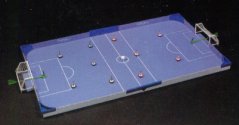
From 1979-80, the NASL started to run an indoor season, which was a separate competition to the usual leagues. Just as Subbuteo used the televised English five-a-side events of the 1970s as a tie-in to their earlier Football Express five-a-side game, so they adopted this NASL variant as a selling point for their Indoor Edition - which featured an NASL game on the lid of the box. While the English catalogues only advertise the full indoor box set, the arena was sold as a separate item in the US (and Canada)
As with "fivesides", which was offered without players in the 1950s, it certainly seemed sensible to sell this set without the players or goals to people who already owned these items with their NASL set. That said, I'm not sure how much cheaper leaving those items out would make this set - it's hardly a big difference. This item isn't on the 1982 price list, but is illustrated on the 1984 poster, and is still on the 1987 price list - for a reasonable $15.00
C1901: Three indoor footballs.
White or orange, smaller sized for indoor play.

Another set that sounds like it might be a new accessory. Of course, it is really just set C145, (or Set FF to all you old timers).
C1950: Subbuteo Sports Bag.
Perfect to store and carry all your Subbuteo
Equipment. 17"x10"x10.5".
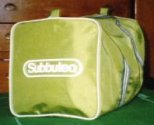
Another item new to the 1984 NASL poster. I've measured my own Subbuteo Sports bag and it just about fits these measurements (I make the end of mine 10x10, but hey, I'm not picky). This item was previously on the Miscellaneous page on my website - but Eddie Lang has sent me a British price list from 1983 showing that it was C200 in the UK.
C1960: Challenge of Soccer
book.
A handbook of soccer skills, techniques and
strategy written by Hubert Vogelsinger.
398 pages with pictures and illustrations.
As the catalogue description indicates, this isn't really a Subbuteo item. But it is on the Jokari 1987 price list, so I've included it here.
C2000: Subbuteo Poster.
Color poster showing all teams and accessories.
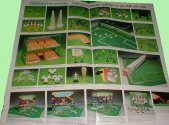
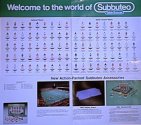
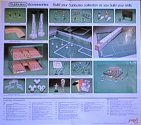
A double sided poster with teams on one side, and accessories on the other. Produced by Jokari, this has some very nice photos of the accessory range. The poster first appears in 1982. The back of this version is shown on the left, in the above illustrations. This version shows three box sets - Club, FIFA World Cup, and NASL. I think the other side has a "front cover" and the team colours must be on the other half of that side. The poster was reissued in 1984 with additional pictures showing the new accessories, but without those illustrating the box sets. My version is this later one, and I've illustrated both sides of this sheet.
C2001: Advanced Rules.
From England. Provides all the official rules
for Tournament competition, plus tips on forming local leagues.
As shown further up this page, Jokari provided their own simple, but clear rule book. In that rule book it suggests that you can get a free copy of the advanced rules from the American Subbuteo Assn, by sending 50 cents to cover postage and handling. By 1984, the English rule book has reached the accessory list. I'm not sure which booklet this is. C116 has left the British lists by this time - having been amalgamated into a bigger Subbuteo handbook in the late 1970s. The British price lists from 1982-83 quote a revised handbook as accessory C192, and perhaps this is the same item as C2001.
That is all the different numbered items in the American range. For completeness, I've listed below all the standard items available to American players. As I've now received details of three years, I've amended the table to show which catalogues the items appeared in.
| No | Details | '82 | '84 | '87 | No | Details | '82 | '84 | '87 |
| C101 | Two Floodlights | Y | Y | Y | C154 | Two tournament goals | Y | Y | Y |
| C102 | Two diving goalkeepers | Y | Y | Y | C158 | Scoreboard | Y | Y | Y |
| C107 | Referee and Linesmen | Y | Y | Y | C166 | Referee's kit | Y | Y | N |
| C108 | Interlocking fence | Y | Y | Y | C167 | Three tournament balls | Y | Y | N |
| C109 | Marked Playing Cloth | Y | Y | Y | C168 | Fifty unpainted spectators | Y | Y | Y |
| C110 | TV Tower | Y | Y | N | C178 | Astropitch | Y | Y | N |
| C123 | Two live-action goalies | N | Y | Y | C179 | Match bench set | Y | Y | N |
| C127 | Three Continental match balls | N | N | Y | C181 | Two championship goals | Y | Y | Y |
| C128 | F A Cup | Y | Y | Y | C182 | FIFA Trophy | Y | Y | N |
| C129 | Number transfers | Y | Y | Y | C183 | Three FIFA balls | Y | Y | N |
| C131 | Two corner kick specialists | Y | Y | Y | C187 | All four packs | Y | N | N |
| C132 | Two throw-in specialists | Y | Y | Y | C188 | Line flags | Y | Y | Y |
| C133 | Six interchangeable goalkeepers | Y | Y | N | C189 | Skills Trainer | N | Y | N |
| C140 | Stadium Grandstand | Y | Y | Y | C191 | Three bouncing balls | N | Y | N |
| C141 | Ten painted spectators | Y | Y | Y | C202 | Two throwing goalies | N | Y | Y |
| C142 | Stadium terracing | Y | Y | Y | C203 | Two kicking goalies | N | Y | Y |
| C143 | Stadium corner terrace unit | Y | Y | Y | C205 | Three Tango balls | N | N | Y |
| C148 | Two standard goals | Y | Y | N | C208 | Outside Broadcast Unit | N | N | Y |
That's all for the American range. The Jokari company are apparently still in existence, but they no longer produce any gaming items.
PS - So what did Waddingtons/Subbuteo Sports Games get in return for this link-up with Jokari. I'm glad you asked..... Check out the Jokari Products 1982 page for details of the sports equipment that was produced under licence for the European market.
[ Main Page ]